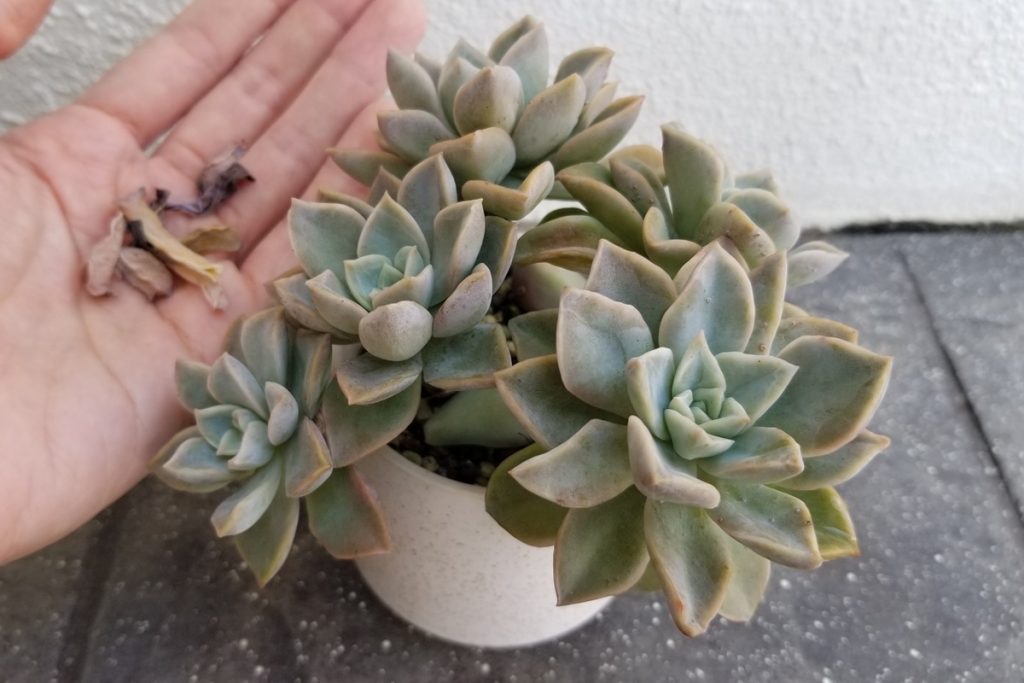Dead Leaves and Succulents: What You Should Know
When we’re taking care of succulents, one thing that often comes up is the issue of dried leaves on the plants. We start to wonder: Does my succulent need more water? Is it sick with a fungus? And if I have a dry leaf, does that mean my whole plant will dry out? So, the big question is: Should I take off the dead leaves from my succulent? But before we answer that, let’s first understand why succulent leaves dry up in the first place.

Contents
Why Are the Bottom Leaves of My Succulent Dying?
Let’s talk about why succulent leaves sometimes dry up. First of all, it’s important to know that when a succulent’s leaves dry up, it doesn’t necessarily mean that the plant is in trouble. Just like any other plant, succulents naturally shed their old leaves as they grow. So, if you see the leaves at the bottom of your succulent drying up, there’s no need to worry because it’s completely normal.
Think of it as a cycle of life. Some leaves die off, while new ones are born to take their place. The lower leaves, being the oldest, dry up to make room for fresh new leaves that grow at the top. These new leaves are healthy and full of life.

Should You Remove Dead Leaves from Succulents?
When it comes to the question of removing dead leaves from succulents, it’s not just about having a neat and tidy plant. It actually plays a vital role in keeping your succulent healthy and thriving. You see, those dead leaves not only make your succulent look a bit sad, but they also create a cozy hiding spot for pesky diseases and unwelcome insects. By removing those dead leaves, you’re not only giving your succulent a fresh and vibrant appearance, but you’re also preventing potential problems from taking root.
So here’s what you should do when you notice dried or dead leaves on your plants:
- Gently remove the dried or dead leaves from the bottom of your succulent. If the leaves are already deflated and yellow, even if they haven’t completely dried, you can still remove them. This helps your plant conserve energy that it can use to develop its new leaves.

- Take a look at the new leaves. If they are healthy, it means your succulent is on the right track. Healthy leaves are not dry, discolored, or shriveled. They have the same color as the rest of the succulent and they are plump.

Preventing Leaf Damage
While we’re talking about removing dead leaves, let’s chat about how we can do it without accidentally causing harm to our precious succulent babies. Now, it’s important to approach this task with a gentle touch. We don’t want to pull too forcefully and risk damaging those lovely healthy leaves nearby.
So, take your time and observe how those little leaves are holding on. If they seem stubbornly attached, just move on for now and come back to them later.
How Often to Remove Dead Leaves from Succulents?

Removing dead leaves shouldn’t just be a one-time thing. It’s essential to make it a regular part of your succulent care routine. Set aside some time every few weeks to inspect your succulents and remove any dead leaves that have appeared. By keeping up with this maintenance routine, you’re not only keeping your succulents looking their best, but you’re also ensuring their overall health and vitality for the long run.
Remember, taking care of your succulents and removing dead leaves is all part of helping them thrive and grow happily.
Signs of Underlying Issues
While dead leaves are a normal part of succulent growth, it’s important to keep an eye out for any signs of excessive or rapid drying. If you notice that your succulent is losing leaves at an alarming rate or if the leaves are drying up more quickly than usual, it could be a sign of underlying issues. Overwatering, underwatering, or even the presence of pesky pests could be to blame. Make sure to closely observe your succulents and address any concerns promptly to keep them in tip-top shape.
Leaf Propagation
Did you know that some succulents can actually propagate from fallen leaves? Yes, it’s like a magical second chance for those dead leaves! If you come across any healthy, intact leaves while removing the dead ones, don’t just discard them. Instead, collect those leaf remnants and give them a chance to grow into new succulents. Place them on a bed of well-draining soil, mist them with some water occasionally, and watch as tiny roots start to sprout. It’s like witnessing nature’s own little miracle right before your eyes.
Special Considerations for Different Succulent Varieties
Not all succulents are created equal, and each variety may have its own specific care needs. Some succulents naturally shed more leaves than others, while some may require extra attention during the process of dead leaf removal. It’s important to familiarize yourself with the specific care instructions for your particular succulent variety. Take the time to research and understand any special considerations or care tips that may be relevant. Remember, knowledge is power when it comes to fostering a flourishing succulent collection.
